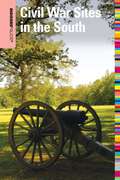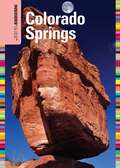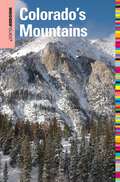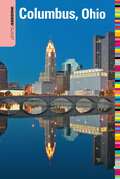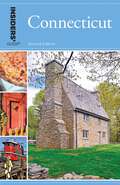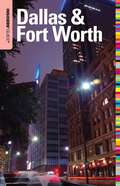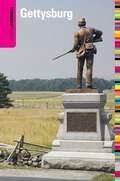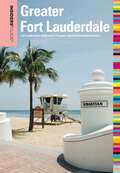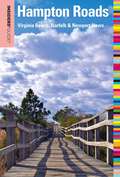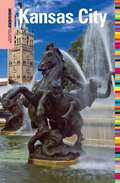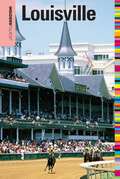- Table View
- List View
Insiders' Guide® to Charleston: Including Mt. Pleasant, Summerville, Kiawah, and Other Islands (Insiders' Guide Series)
by Lee Davis PerryInsiders' Guide to Charlestonis the essential source for in-depth travel and relocation information to this charming southern city. Written by locals (and true insiders), it offers a personal and practical perspective of Charleston and its surrounding environs. With over two-million books sold, Insiders&’ Guides are the essential source for in-depth travel and relocation information making them an indispensable guide for travelers and residents alike.
Insiders' Guide® to Charlotte (Insiders' Guide Series)
by Craig DistlSkyscrapers. Sports. NASCAR. Nature. Culinary delights.A world-class, can-do city. A crown jewel of the New South. • A personal, practical perspective for travelers and residents alike• Comprehensive listings of attractions, restaurants, and accommodations• How to live & thrive in the area—from recreation to relocation• Countless details on shopping, arts & entertainment, and children&’s activities Our insider, Craig Distl, a native of North Carolina and a longtime Charlottean, has been a journalist for the Charlotte Observer, and his articles have also appeared in Charlotte Magazine, Southern Sports Journal, and Golfweek. His writing has received awards from such organizations as the North Carolina Press Association.
Insiders' Guide® to Cincinnati (Insiders' Guide Series)
by Felix Winternitz Sacha BellmanFor those looking to visit Cincinnati or considering moving there, Insiders&’ Guide to Cincinnati is the essential source for information about this thriving Ohio city. Written by locals with first-hand experience in the region, this exceedingly useful and practical guide offers a personal perspective of Cincinnati and its surroundings and includes three maps of the area.
Insiders' Guide® to Civil War Sites in the South (Insiders' Guide Series)
by Shannon LaneCivil War history buffs will love this unique travel guide to the South's most famous and infamous battle sites, including historical background, directions to hard-to-find locations, and tips on where to stay, eat, and shop.
Insiders' Guide® to Colorado Springs (Insiders' Guide Series)
by Linda Duval Marty BanksYour Travel Destination. Your Home. Your Home-To-Be.Colorado SpringsHit the museums. Savor the cuisine. Stroll in the Garden of the Gods. Head up Pike&’s Peak. Experience the best of this healthful, family-friendly place.• A personal, practical perspective for travelers and residents alike• Comprehensive listings of attractions, restaurants, and accommodations• How to live & thrive in the area—from recreation to relocation• Countless details on shopping, arts & entertainment, and children&’s activities
Insiders' Guide® to Colorado's Mountains (Insiders' Guide Series)
by Charles AgarFor more than twenty years, the Insiders&’ Guide® series has been the essential source for in-depth travel and relocation information—from true insiders whose personal, practical perspective gives you everything you need to know. Whether you&’re just zipping through Colorado&’s mountains or settling into a new mountain lifestyle, there&’s something enchanting about their out-of-the-way little valleys, high alpine meadows, old mining towns, and, yes, modern ski megalopolises. This authoritative guide shows you how to navigate each of the region&’s unique areas, from Steamboat Springs to Aspen and on south to Durango, where you&’ll discover everything from the best powder to fine dining with a view. Inside You&’ll Find: • Countless details on how to live and thrive in the area, from the best shopping to the lowdown on real estate• The inside scoop on the best ski resorts, as well as on attractions, the arts, and summer activities, such as golfing, fishing, camping, backpacking, and health spas• Comprehensive listings of restaurants, accommodations, and popular events• Sections dedicated to chil dren and retirement
Insiders' Guide® to Columbus (Insiders' Guide Series)
by Shawnie KelleyEverything you need to know about the nation's fourteenth largest city. Whether you plan to pursue an education, start a business or a job, or raise a family in Columbus, this guide helps you to travel deeper into the rapidly growing Capital City of Ohio.
Insiders' Guide® to Columbus, Ohio (Insiders' Guide Series)
by Shawnie KelleyEverything you need to know about the nation&’s fifteenth largest city! Whether you plan to pursue an education, start a business, or raise a family, this guide takes you through the rapidly growing Discovery City.
Insiders' Guide® to Connecticut (Insiders' Guide Series)
by Eric D. LehmanInsiders' Guide to Connecticut is the essential source for in-depth travel information for visitors and locals to the Nutmeg State. Written by a local (and true insider), Insiders' Guide to Connecticut offers a personal and practical perspective of the state that makes it a must-have guide for travelers as well as residents looking to rediscover their home state.
Insiders' Guide® to Dallas & Fort Worth (Insiders' Guide Series)
by June NaylorYour Travel Destination. Your Home. Your Home-To-Be.Dallas & Fort Worth&“Fort Worth is where the West begins,&” it&’s said, &“and Dallas is where the East peters out.&” • A personal, practical perspective for travelers and residents alike• Comprehensive listings of attractions, restaurants, and accommodations• How to live & thrive in the area—from recreation to relocation• Countless details on shopping, arts & entertainment, and children&’s activities
Insiders' Guide® to Denver (Insiders' Guide Series)
by Eric LindbergInsiders' Guide to Denver is the essential source for in-depth travel information for visitors and locals alike to this storied Colorado city. Written by a local, and true insider, Insiders' Guide to Denver offers a personal and practical perspective of Denver and its surrounding environs that makes it a must-have guide for travelers as well as residents looking to rediscover their hometown.
Insiders' Guide® to Des Moines (Insiders' Guide Series)
by Michael ReamA first edition, Insiders' Guide to Des Moines is the essential source for in-depth travel and relocation information to Iowa's capital. Written by a local (and true insider), this guide offers a personal and practical perspective of Des Moines and its surrounding environs.
Insiders' Guide® to El Paso (Insiders' Guide Series)
by Megan EavesA first edition, Insiders' Guide to El Paso is the essential source for in-depth travel and relocation information to this legendary Texas panhandle area with wild west charm. Written by a local (and true insider), this guide offers a personal and practical perspective of El Paso and its surrounding environs.
Insiders' Guide® to Florida Keys & Key West
by Juliet Dyal GrayWritten by a local and true insider, Insiders' Guide to Florida Keys & Key West is the essential source for in-depth travel and relocation information. Each guide is packed with useful tips on places to stay, restaurants, events, attractions, fun things to do with the kids, nightlife, recreation, shopping, local history, and much more--as well as information on real estate, education, health care, and more.The new edition features:Comprehensive listings of restaurants, attractions, activities, nightlife, and accommodationsCountless details on shopping, arts & entertainment, and children&’s activitiesAdvice on how to live and thrive in the area—from recreation to relocation
Insiders' Guide® to Gettysburg (Insiders' Guide Series)
by Kate HertzogInsiders' Guide to Gettysburg is the essential source for in-depth travel and relocation information to this historic city.
Insiders' Guide® to Greater Fort Lauderdale: Fort Lauderdale, Hollywood, Pompano, Dania & Deerfield Beaches (Insiders' Guide Series)
by Steve Winston Caroline SiegA first edition, Insiders' Guide to Greater Fort Lauderdale is the essential source for in-depth travel and relocation information to this beautiful Florida region. Written by a local (and true insider), this guide offers a personal and practical perspective of Fort Lauderdale and its surrounding environs.
Insiders' Guide® to Hampton Roads: Virginia Beach, Norfolk & Newport News (Insiders' Guide Series)
by Anthony GermanottaA first edition, Insiders' Guide to Hampton Roads is the essential source for in-depth travel and relocation information to this storied Virginia metropolitan area. Written by a local (and true insider), this guide offers a personal and practical perspective of Hampton Roadsand its surrounding environs.
Insiders' Guide® to Houston (Insiders' Guide Series)
by Laura Nathan-GarnerFor more than twenty years, the Insiders' Guide series has remained the essential source for in-depth travel and relocation information. Written by locals and true insiders, each guide is packed with useful tips on places to stay, restaurants, events, attractions, fun thnigs to do with the kids, nightlife, recreation, shopping, local history, and much more--as well as a comprehensive appendix called "Living Here" that offers information on real estate, education, health care, and more.
Insiders' Guide® to Indianapolis (Insiders' Guide Series)
by Jackie Sheckler FinchA first edition, Insiders' Guide to Indianapolis is the essential source for in-depth travel and relocation information to Indiana's capital city. Written by a local (and true insider), this guide offers a personal and practical perspective of Indianapolis and its surrounding environs.
Insiders' Guide® to Jacksonville (Insiders' Guide Series)
by Sarah ReissYour Travel Destination. Your Home. Your Home-To-Be.JacksonvilleA fast-growing Southern city. Historical landmarks aplenty. Family-style fare and fine cuisine. A robust business scene. World-class resorts. Sandy beaches galore. • A personal, practical perspective for travelers and residents alike• Comprehensive listings of attractions, restaurants, and accommodations• How to live & thrive in the area—from recreation to relocation• Countless details on shopping, arts & entertainment, and children&’s activities
Insiders' Guide® to Kansas City (Insiders' Guide Series)
by Katie Van LucheneYour Travel Destination. Your Home. Your Home-To-Be.Kansas CityWorld-class museums. Historic jazz clubs. Romantic cafes. Riverboat casinos. High-end cuisine. Down-home barbecues. • A personal, practical perspective for travelers and residents alike• Comprehensive listings of attractions, restaurants, and accommodations• How to live & thrive in the area—from recreation to relocation• Countless details on shopping, arts & entertainment, and children&’s activities
Insiders' Guide® to Long Island (Insiders' Guide Series)
by Jason RichYour Travel Destination. Your Home. Your Home-To-Be.Long IslandExplore a 118-mile-long reason to love New York. Experience the best of Nassau and Suffolk Counties. Savor the beaches, the fresh seafood, the local wines.• A personal, practical perspective for travelers and residents alike• Comprehensive listings of attractions, restaurants, and accommodations• How to live & thrive in the area—from recreation to relocation• Countless details on shopping, arts & entertainment, and children&’s activities
Insiders' Guide® to Louisville (Insiders' Guide Series)
by David DomineInsiders' Guide to Louisville is the essential source for in-depth travel and relocation information to this storied Kentucky city. Written by a local (and true insider), this guide offers a personal and practical perspective of Louisville and its surrounding environs.
Insiders' Guide® to Madison, WI (Insiders' Guide Series)
by Kevin RevolinskiA first edition, Insiders' Guide to Madison is the essential source for in-depth travel and relocation information to this thriving Wisconsin city. Written by a local (and true insider), this guide offers a personal and practical perspective of Madison and its surrounding environs.
Insiders' Guide® to Massachusetts (Insiders' Guide Series)
by Maria OliaInsiders' Guide to Massachusetts is the essential source for in-depth travel information for visitors and locals to the Bay State. Written by a local, and true insider, Insiders' Guide to Massachusetts offers a personal and practical perspective of the state that makes it a must-have guide for travelers as well as residents looking to rediscover their home state.



